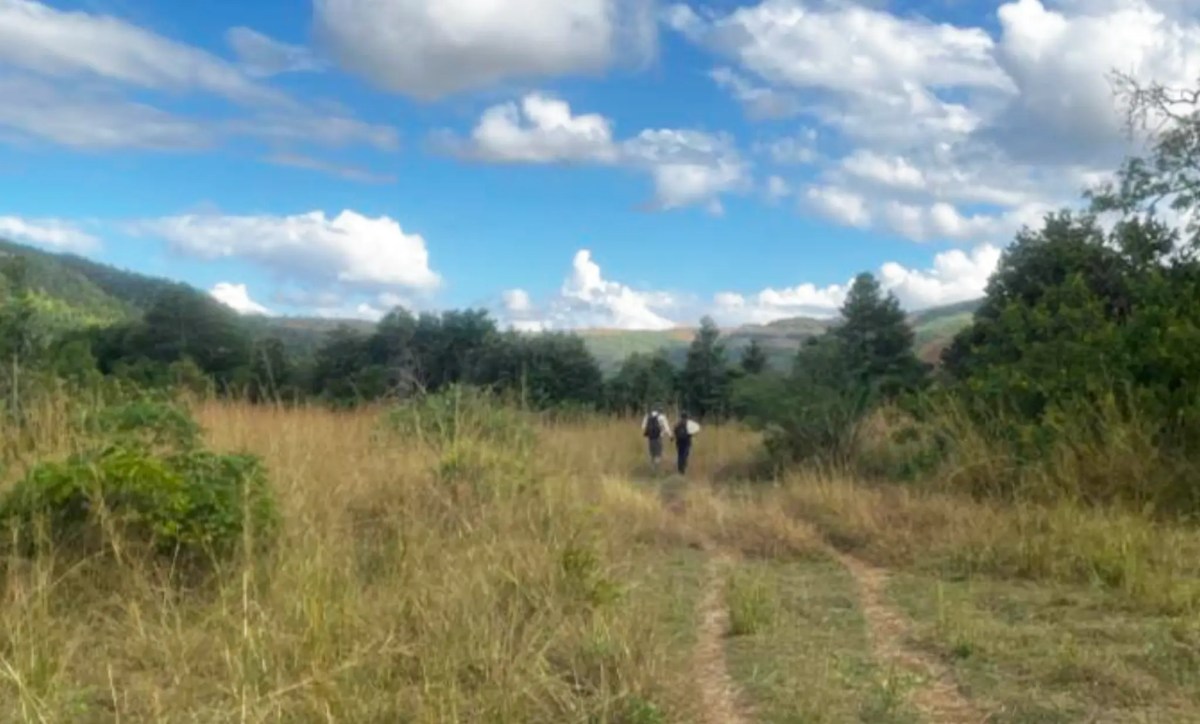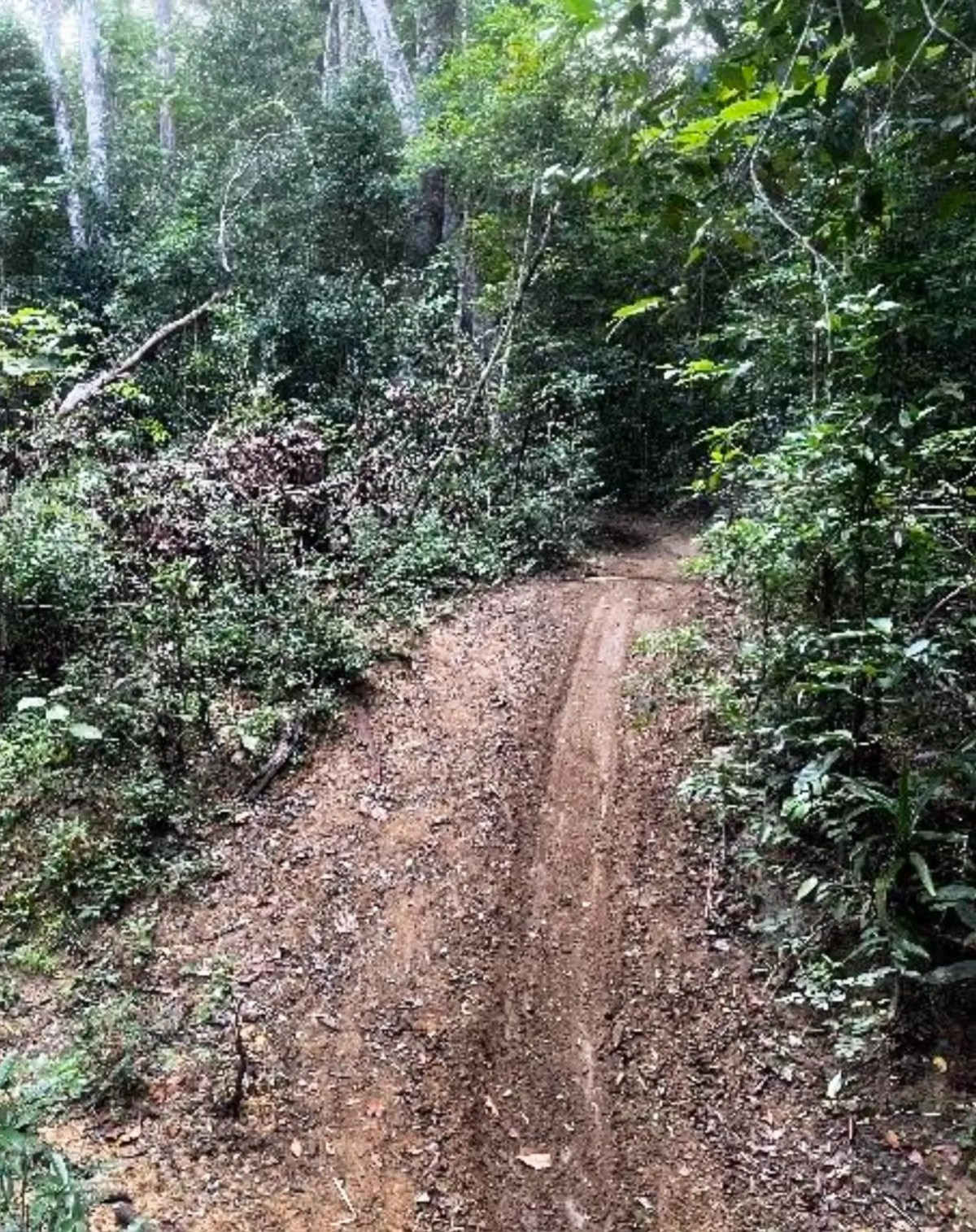A Wild Trek, Part 2
Tim Eppley’s and Lytah Razafimahefa’s field site scouting expedition continues!
Day 4 —Mosorolava to Ankavana
On our fourth day, we hiked 12 km across savanna, passing through a few small to medium villages, and briefly stopped in Andziamena to chat with locals and visit the elementary school. In the afternoon, we hiked southwest, with large fields on either side growing peanuts and maize. In the distance we could see large forest fragments on the hills, often with the forests restricted to the rocky valleys and the other areas cut and burned to provide grazing land for zebu.


Entering the Ankavana forest, we came across a small homestead owned by a young man named Bora. Bora had extensive rice paddies between his home and the forest, as well as zebu and zebu carts on his land. In the forest, we saw large paths that had been very recently used to drag timber blocks/beams out. These paths were exceptionally wide, and large stumps or downed trees were visible despite the high canopy. The forest was semi-humid, with some enormous trees that had canopies nearing 30 meters tall. It was unlike any dry deciduous forest I had been in. It was a beautiful forest, even if there was a cut tree every five meters. Interestingly, there was an irrigation ditch that ran along the trail, and we set up camp in this area.




We programmed 4 of our camera traps and set them up in clear areas 50 to 150 meters from camp. Near one site we found an active laly snare, which targets lemurs. We deactivated this snare, and thankfully it was the only one that we saw within the area. Still, not a great start to know that one of best places to see one of the world’s most endangered primates was the active site of intensive logging and some hunting.
That night, we walked along the trails and saw sportive lemurs, a mouse lemur, tree boa, velvet gecko, panther chameleons, and Oustalet’s chameleons. As soon as it got dark, a large group of crowned lemurs began feeding and vocalizing near camp. At this time of year, which is typically referred to as the lean season, many true lemur species sleep more during the day and become more active at night.
Day 5 — Ankavana
After breakfast, we followed Bora up a seasonal riverbed to the southwest. Along the route, we observed at least one felled tree every five meters. Many of these were very large trees for a dry deciduous forest. Several had been cut into large chunks, about two meters long with a notch on the end, which is used to tie them to zebu for dragging out of the forest. According to Bora, a single zebu can drag three of these timber chunks back to his homestead, at which point he loads a bunch of them on a cart and takes them to a half-way point, where they are transferred to a truck.

The park ranger who was with us did not seem bothered by the fact that this supposedly protected forest is actively being logged. We pressed him to tell us what he does when he finds these signs of illegal extraction, and he showed us that he writes up the information in his notebook and then cut notches in the side of the large planks to let the illegal loggers know he was there. Whether this gets reported to officials or not is questionable. Unfortunately, park agents have zero authority. When there are multiple serious infractions recorded, they are supposed to bring in the gendarmes to make arrests—but typically those wanted are informed and clear out days before the gendarmes arrive. In fact, this would appear to have been the case prior to our own arrival at the site.
We continued to wander the site for the rest of the day, walking ridgelines, going down into the valley to walk along the river, which was quite beautiful, and crossing between sharp karst outcroppings toward the top of the forested hills. As beautiful as it was, the site presented considerably dangerous situations if chasing after lemurs or other quick wildlife. Limestone karst is extremely sharp and can cut through the soles of hiking boots, and if you take a fall on a hill, you better hope that you avoid hitting the rock along those sharp edges! It rained heavily in the afternoon, and all was quiet until that evening, when again, a group of crowned lemurs moved over our campsite.

Day 6 — Ankavana
Being our last full day in Ankavana, I was determined to observe the Perrier’s sifaka. We began by searching the area to the east of the river, and then ascended to the ridgeline. We stopped every so often to simply listen for movement. There was still a good amount of water on the leaves from the rain, so any movement in the canopy would be easily heard. We observed a small group of crowned lemurs, but as is typical of lemurs in an area under heavy pressure, they immediately fled and barely alarm called.
I spent the rest of the day searching along the river, traveling further south into the site. The canopy became lower, and the forest was denser, but I did not hear or observe any lemurs. Unfortunately, none of us saw or heard any Perrier’s sifaka. That doesn’t mean that they are not there, it just means that if they are present, there are likely few individuals and may not constitute a viable population.
Day 7 — Ankavana to Anivorano to Ambilobe
I retrieved the camera traps around 6 am. I was excited to scroll through them to see if we “captured” anything, but unfortunately, we did not. This is not unusual. We only set 4 cameras for 3 nights, and even when I’ve had 20 cameras for a month, they may all go a few days or more without capturing any animal photos.
Our plan was to reach Anivorano by the early afternoon, but around 6 km into the hike, the park agent asked us if we wanted to see a waterfall. Sure! We walked back through the peanut farming areas and could eventually hear it. We were shocked when we saw it: it was probably 20 to 25 meters across with an 8- to 10-meter drop. This massive waterfall was unlike any that we had seen in Madagascar so far. This was the Cascade d’Antsarorobe, along the Irodo River. There are some high waterfalls in Madagascar, but this was just massive, and even during the dry season, it was flowing at a fast pace. We all agreed that this would make for an incredible ecolodge site, but the negatives are that it is in the middle of the savanna, with nearby agriculture, and it isn’t actually within the protected area’s boundaries. Still, this was a definite highlight of our expedition.

To continue our hike toward the RN6 main road, we had to descend the cliffs and cross the river in front of the waterfall. From the base, it was a great view and a beautiful area. From there, we proceeded to walk along rice paddies and other zebu grazing fields. We saw raptors, smaller birds, and some chameleons. Eventually we reached the large village of Antsoha, where there is a general store and a better road/path to the RN6. We had phone reception, so we contacted the driver, and he was able to come pick us up from the village. From Anivorano, it would be about 3.5- to 4-hour drive to the town of Ambilobe, where we would remain for the next few days before going to a meeting scheduled with the local MNP director. Then we’d be headed home!
This expedition was an amazing experience. We observed and learned a great deal along the way, which we can apply to planning for Wildlife Madagascar and what we want to accomplish with our field work. We had one more trip to take, in August, to see and review a couple more sites. On to the next!
Read the conclusion of the site search in Tim’s next post!
